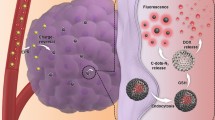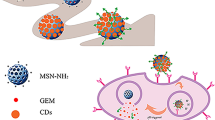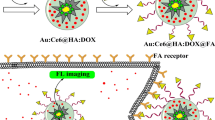Abstract
In recent years, fluorescent carbon dots (CDs) have attracted a great deal of attention in imaging and related biomedical applications due to their excellent photoluminescence properties, low cost, high quantum yield and low cytotoxicity in comparison with semiconductor quantum dots based on metallic elements. In this paper, a new and simple design for development of CDs/gelatin nanoparticles (CDs/GNPs) is described which used as a novel methotrexate (MTX) nanocarrier and MCF-7 cell imaging. The obtained fluorescent nanocarriers were characterized using FTIR, SEM, XRD, DLS, PL, TGA, and zeta-potential analysis. Afterward, the performance of developed NPs was investigated through different in vitro tests such as MTT assay, fluorescence microscopy, and flow cytometry analyses. MTX was successfully loaded into the fluorescent NPs at physiological pH (7.4) by ionic interactions between anionic carboxylate groups of MTX and cationic amino groups on the surface of NPs. MTX releasing ability of the obtained nanocarrier was illustrated through the comparison of in vitro drug release at both simulated tumor tissue and physiological environment. The MTT assay revealed that the MTX-loaded nanocarriers have higher cytotoxicity in MCF-7 breast cancer cells than nanocarriers without MTX. Upon the obtained results, our fluorescent nanocarriers hold great potential as drug delivery carriers for the targeted MTX delivery to the cancer cells and biological fluorescent labeling.










Similar content being viewed by others
References
Smith BR, Gambhir SS (2017) Nanomaterials for in vivo imaging. Chem Rev 117(3):901–986
Kim S, Choi Y, Park G, Won C, Park Y-J, Lee Y, Kim B-S, Min D-H (2017) Highly efficient gene silencing and bioimaging based on fluorescent carbon dots in vitro and in vivo. Nano Res 10(2):503–519
Gun’ko YK (2016) Nanoparticles in bioimaging. Multidisciplinary Digital Publishing Institute, Basel
Jin G, He R, Liu Q, Dong Y, Lin M, Li W, Xu F (2018) Theranostics of triple-negative breast cancer based on conjugated polymer nanoparticles. ACS Appl Mater Interfaces 10(13):10634–10646
Jin G, Zhao X, Xu F (2017) Therapeutic nanomaterials for cancer therapy and tissue regeneration. Drug Discov Today 22(9):1285–1287
Jin G, Feng G, Qin W, Tang BZ, Liu B, Li K (2016) Multifunctional organic nanoparticles with aggregation-induced emission (AIE) characteristics for targeted photodynamic therapy and RNA interference therapy. Chem Commun 52(13):2752–2755
Zhu S, Song Y, Zhao X, Shao J, Zhang J, Yang B (2015) The photoluminescence mechanism in carbon dots (graphene quantum dots, carbon nanodots, and polymer dots): current state and future perspective. Nano Res 8(2):355–381
Sundar S, Kundu J, Kundu SC (2010) Biopolymeric nanoparticles. Sci Technol Adv Mater 11(1):014104
Kamaly N, Xiao Z, Valencia PM, Radovic-Moreno AF, Farokhzad OC (2012) Targeted polymeric therapeutic nanoparticles: design, development and clinical translation. Chem Soc Rev 41(7):2971–3010
Zeng Q, Shao D, He X, Ren Z, Ji W, Shan C, Qu S, Li J, Chen L, Li Q (2016) Carbon dots as a trackable drug delivery carrier for localized cancer therapy in vivo. J Mater Chem B 4(30):5119–5126
Kang Z, Liu Y, Lee S-T (2017) Carbon dots for bioimaging and biosensing applications. In: Springer series on chemical sensors and biosensors (methods and applications). Springer, Berlin, Heidelberg, pp 1–31
Jelinek R (2017) Biological applications of carbon-dots. In: Carbon quantum dots. Springer, pp 47–60
Foox M, Zilberman M (2015) Drug delivery from gelatin-based systems. Exp Opin Drug Deliv 12(9):1547–1563
Mironova M, Kovaleva E (2017) Comparative analysis of quality assessment requirements for gelatin used in drug production. Pharm Chem J 50(12):820–825
Liu S, Liu X, Han MY (2016) Controlled modulation of surface coating and surface charging on quantum dots with negatively charged gelatin for substantial enhancement and reversible switching in photoluminescence. Adv Funct Mater 26(48):8991–8998
Huang G, Li F, Zhao X, Ma Y, Li Y, Lin M, Jin G, Lu TJ, Genin GM, Xu F (2017) Functional and biomimetic materials for engineering of the three-dimensional cell microenvironment. Chem Rev 117(20):12764–12850
MaHam A, Tang Z, Wu H, Wang J, Lin Y (2009) Protein-based nanomedicine platforms for drug delivery. Small 5(15):1706–1721
Kumari A, Yadav SK, Yadav SC (2010) Biodegradable polymeric nanoparticles based drug delivery systems. Colloids Surf B Biointerfaces 75(1):1–18
Byrne SJ, Williams Y, Davies A, Corr SA, Rakovich A, Gun’ko YK, Rakovich YP, Donegan JF, Volkov Y (2007) “Jelly dots”: synthesis and cytotoxicity studies of CdTe quantum dot–gelatin nanocomposites. Small 3(7):1152–1156
Chen L, Siemiarczuk A, Hai H, Chen Y, Huang G, Zhang J (2014) Development of biocompatible and proton-resistant quantum dots assembled on gelatin nanospheres. Langmuir 30(7):1893–1899
Wang Y, Chen H, Ye C, Hu Y (2008) Synthesis and characterization of CdTe quantum dots embedded gelatin nanoparticles via a two-step desolvation method. Mater Lett 62(19):3382–3384
Chen L, Willoughby A, Zhang J (2014) Luminescent gelatin nanospheres by encapsulating CdSe quantum dots. Luminescence 29(1):74–78
Girija Aswathy R, Sivakumar B, Brahatheeshwaran D, Ukai T, Yoshida Y, Maekawa T, Kumar SD (2011) Biocompatible fluorescent jelly quantum dots for bioimaging. Mater Express 1(4):291–298
Mansur HS, Mansur AA, Curti E, De Almeida MV (2012) Bioconjugation of quantum-dots with chitosan and N,N,N-trimethyl chitosan. Carbohydr Polym 90(1):189–196
Gao Z, Shen G, Zhao X, Dong N, Jia P, Wu J, Cui D, Zhang Y, Wang Y (2013) Carbon dots: a safe nanoscale substance for the immunologic system of mice. Nanoscale Res Lett 8(1):276
Wang J, Qiu J (2016) A review of carbon dots in biological applications. J Mater Sci 51(10):4728–4738. https://doi.org/10.1007/s10853-016-9797-7
Purcell WT, Ettinger DS (2003) Novel antifolate drugs. Curr Oncol Rep 5(2):114–125
Visser K, Van der Heijde D (2009) Risk and management of liver toxicity during methotrexate treatment in rheumatoid and psoriatic arthritis: a systematic review of the literature. Clin Exp Rheumatol 27(6):1017–1025
Grim J, Chládek J, Martínková J (2003) Pharmacokinetics and pharmacodynamics of methotrexate in non-neoplastic diseases. Clin Pharmacokinet 42(2):139–151
Abolmaali SS, Tamaddon AM, Dinarvand R (2013) A review of therapeutic challenges and achievements of methotrexate delivery systems for treatment of cancer and rheumatoid arthritis. Cancer Chemother Pharmacol 71(5):1115–1130
Chen J, Huang L, Lai H, Lu C, Fang M, Zhang Q, Luo X (2013) Methotrexate-loaded PEGylated chitosan nanoparticles: synthesis, characterization, and in vitro and in vivo antitumoral activity. Mol Pharm 11(7):2213–2223
Rahimi M, Shojaei S, Safa KD, Ghasemi Z, Salehi R, Yousefi B, Shafiei-Irannejad V (2017) Biocompatible magnetic tris (2-aminoethyl) amine functionalized nanocrystalline cellulose as a novel nanocarrier for anticancer drug delivery of methotrexate. New J Chem 41(5):2160–2168
Yang L, Jiang W, Qiu L, Jiang X, Zuo D, Wang D, Yang L (2015) One pot synthesis of highly luminescent polyethylene glycol anchored carbon dots functionalized with a nuclear localization signal peptide for cell nucleus imaging. Nanoscale 7(14):6104–6113
Rezaei SJT, Abandansari HS, Nabid MR, Niknejad H (2014) pH-responsive unimolecular micelles self-assembled from amphiphilic hyperbranched block copolymer for efficient intracellular release of poorly water-soluble anticancer drugs. J Colloid Interface Sci 425:27–35
Li W, Li J, Gao J, Li B, Xia Y, Meng Y, Yu Y, Chen H, Dai J, Wang H (2011) The fine-tuning of thermosensitive and degradable polymer micelles for enhancing intracellular uptake and drug release in tumors. Biomaterials 32(15):3832–3844
Cao L, Wang X, Meziani MJ, Lu F, Wang H, Luo PG, Lin Y, Harruff BA, Veca LM, Murray D (2007) Carbon dots for multiphoton bioimaging. J Am Chem Soc 129(37):11318–11319
Feng T, Ai X, An G, Yang P, Zhao Y (2016) Charge-convertible carbon dots for imaging-guided drug delivery with enhanced in vivo cancer therapeutic efficiency. ACS Nano 10(4):4410–4420
Zheng M, Ruan S, Liu S, Sun T, Qu D, Zhao H, Xie Z, Gao H, Jing X, Sun Z (2015) Self-targeting fluorescent carbon dots for diagnosis of brain cancer cells. ACS Nano 9(11):11455–11461
Azimi B, Nourpanah P, Rabiee M, Arbab S (2014) Producing gelatin nanoparticles as delivery system for bovine serum albumin. Iran Biomedi J 18(1):34–40
Gao M, Kirstein S, Möhwald H, Rogach AL, Kornowski A, Eychmüller A, Weller H (1998) Strongly photoluminescent CdTe nanocrystals by proper surface modification. J Phys Chem B 102(43):8360–8363
Zhang H, Zhou Z, Yang B, Gao M (2003) The influence of carboxyl groups on the photoluminescence of mercaptocarboxylic acid-stabilized CdTe nanoparticles. J Phys Chem B 107(1):8–13
Rahman M, Dey K, Parvin F, Sharmin N, Khan RA, Sarker B, Nahar S, Ghoshal S, Khan M, Billah MM (2011) Preparation and characterization of gelatin-based PVA film: effect of gamma irradiation. Int J Polym Mater 60(13):1056–1069
Peng H, Xiong H, Li J, Xie M, Liu Y, Bai C, Chen L (2010) Vanillin cross-linked chitosan microspheres for controlled release of resveratrol. Food Chem 121(1):23–28
Karthikeyan S, Prasad NR, Ganamani A, Balamurugan E (2013) Anticancer activity of resveratrol-loaded gelatin nanoparticles on NCI-H460 non-small cell lung cancer cells. Biomed Prev Nutr 3(1):64–73
Wang Y, Zhao Q, Han N, Bai L, Li J, Liu J, Che E, Hu L, Zhang Q, Jiang T (2015) Mesoporous silica nanoparticles in drug delivery and biomedical applications. Nanomed Nanotechnol Biol Med 11(2):313–327
Bajpai A, Choubey J (2005) Release study of sulphamethoxazole controlled by swelling of gelatin nanoparticles and drug-biopolymer interaction. J Macromol Sci Part A Pure Appl Chem 42(3):253–275
Kimelberg HK, Tracy TF, Biddlecome SM, Bourke RS (1976) The effect of entrapment in liposomes on the in vivo distribution of [3H] methotrexate in a primate. Cancer Res 36(8):2949–2957
Guo M, Yan Y, Liu X, Yan H, Liu K, Zhang H, Cao Y (2010) Multilayer nanoparticles with a magnetite core and a polycation inner shell as pH-responsive carriers for drug delivery. Nanoscale 2(3):434–441
Meloun M, Ferenčíková Z, Vrána A (2010) The thermodynamic dissociation constants of methotrexate by the nonlinear regression and factor analysis of multiwavelength spectrophotometric pH-titration data. Open Chem 8(3):494–507
Ghorbani M, Hamishehkar H, Arsalani N, Entezami AA (2016) A novel dual-responsive core-crosslinked magnetic-gold nanogel for triggered drug release. Mater Sci Eng, C 68:436–444
Ghorbani M, Hamishehkar H (2017) Redox and pH-responsive gold nanoparticles as a new platform for simultaneous triple anti-cancer drugs targeting. Int J Pharm 520(1):126–138
Acknowledgements
The authors gratefully acknowledge the University of Tabriz and the Drug Applied Research Center, Tabriz University of Medical Sciences.
Author information
Authors and Affiliations
Corresponding authors
Rights and permissions
About this article
Cite this article
Nezhad-Mokhtari, P., Arsalani, N., Ghorbani, M. et al. Development of biocompatible fluorescent gelatin nanocarriers for cell imaging and anticancer drug targeting. J Mater Sci 53, 10679–10691 (2018). https://doi.org/10.1007/s10853-018-2371-8
Received:
Accepted:
Published:
Issue Date:
DOI: https://doi.org/10.1007/s10853-018-2371-8




